博弈论9-2. Cheap Talk 与直接显示机制
- 格式:pptx
- 大小:490.37 KB
- 文档页数:42

博弈论平话王则柯著中信出版社图书在版编目(CIP)数据博弈论平话/王则柯著. —北京:中信出版社,2011.4ISBN 978–7–5086–2656–7I. 博…II. 王…III. 对策论-普及读物IV. F224.32中国版本图书馆CIP数据核字(2011)第017280号博弈论平话BOYILUN PINGHUA著 者:王则柯策划推广:中信出版社(China CITIC Press)出版发行:中信出版集团股份有限公司(北京市朝阳区惠新东街甲4号富盛大厦2座邮编100029)(CITIC Publishing Group)承 印 者:开 本:787mm×1092mm 1/16 印 张:16.75 字 数:160千字版 次:2011年4月第1版印 次:2011年4月第1次印刷书 号:ISBN 978–7–5086–2656–7/F·2245定 价:39.00元版权所有·侵权必究凡购本社图书,如有缺页、倒页、脱页,由发行公司负责退换。
服务热线:010–84849283 http: // 服务传真:010–84849000 E-mail: sales@ author@目录前言·VII第一章 博弈三要素与囚徒困境·1民营书店的价格大战·3我怎样被博弈论吸引·6如此不公平,取胜概率却相等·10囚徒困境与博弈三要素·13从囚徒困境说严格优势策略均衡·16价格大战和双赢对局·19为什么主要讨论非合作博弈·22公共品供给的囚徒困境·25政治家的囚徒困境·28基数支付和序数支付·30美苏争霸的囚徒困境·33第二章 情侣博弈和协调博弈·37情侣博弈和纳什均衡·39情侣博弈的其他例子·42相对优势策略下划线法·45视觉友好的对角排列·48情侣博弈表达的对称性嗜好·51理性人一定自私自利吗?·54不该一律贬斥自利行为·57情侣的拥挤博弈·60默契是协调的一种方式·63劣势策略消去法的讨论·65第三章 简单博弈模型的应用·69智猪博弈和搭便车行为·71为什么大股东挑起监督经理的重任·74猎人博弈和帕累托优势·76斗鸡博弈和航行规则·79银行挤兑的成因和预防·83数据不同,结果各异·86囚徒困境两败俱伤的隐含条件·89禁鸣喇叭与交通顺畅·95串通作弊和风险优势·98营造克己奉公的制度环境·101“最惠客待遇”对谁有利·104风险优势的判定·107说说风险优势的从属地位·110风险厌恶的统计和理论·113| IV | 博弈论平话 |第四章 混合策略与均衡筛选·117扑克牌对色游戏·119混合策略和纳什定理·122寻找纳什均衡的反应函数法·125再说混合策略纳什均衡·130扑克牌讹诈游戏·136慕尼黑谈判模拟·141聚点均衡·143聚点均衡作为共识均衡·146聚点均衡的制度设置·148相关均衡·151商品品牌的“地域连坐”效应·154品牌地域连坐的博弈分析·157抗共谋均衡·161盯着不散伙的共谋·165德国世界杯警方的优势策略·169第五章 零和博弈与霍特林模型·173零和博弈与非零和博弈·175均衡的观察与验证·179纳什均衡与杂货铺定位·183西方两党政治的稳定性和欺骗性·187| 目录 | V |动机和实现不是一回事·191摊贩为什么都往市场门口挤?·193学校门口等出租车的争先行为·196多人博弈的霍特林模型·199对抗性排序·207经济学家的对称性偏好·211第六章 动态博弈和子博弈精炼均衡·215抓钱游戏·217你死我活,还是你好我好·221编排故事,加深理解·224博弈结果依赖制度设置·227树型博弈策略组合的粗线表示·230确定树博弈的纳什均衡·234树型博弈的子博弈·237子博弈精炼纳什均衡·240求解动态博弈的倒推法·244博弈论向自己出难题·247实验经济学和行为经济学·250索引·253| VI | 博弈论平话 |最近四五十年,经济学经历了一场博弈论革命。
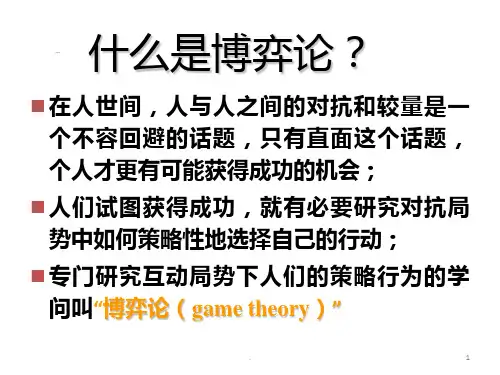

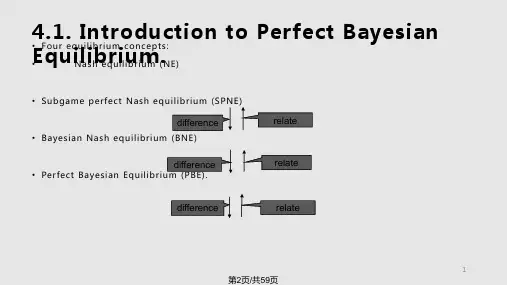

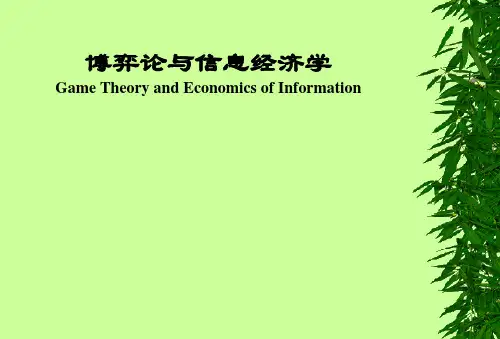
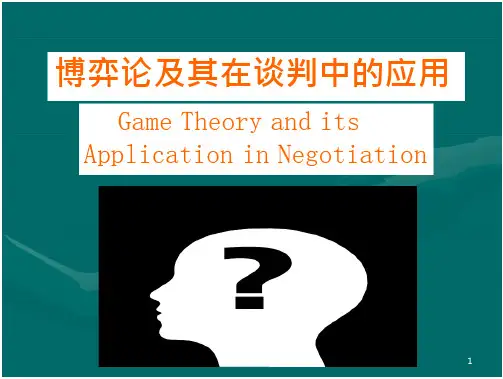
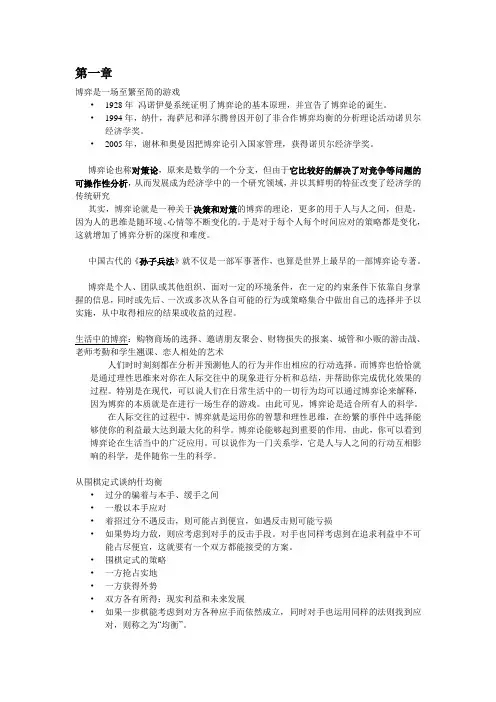
第一章博弈是一场至繁至简的游戏•1928年冯诺伊曼系统证明了博弈论的基本原理,并宣告了博弈论的诞生。
•1994年,纳什,海萨尼和泽尔腾曾因开创了非合作博弈均衡的分析理论活动诺贝尔经济学奖。
•2005年,谢林和奥曼因把博弈论引入国家管理,获得诺贝尔经济学奖。
博弈论也称对策论,原来是数学的一个分支,但由于它比较好的解决了对竞争等问题的可操作性分析,从而发展成为经济学中的一个研究领域,并以其鲜明的特征改变了经济学的传统研究其实,博弈论就是一种关于决策和对策的博弈的理论,更多的用于人与人之间,但是,因为人的思维是随环境、心情等不断变化的。
于是对于每个人每个时间应对的策略都是变化,这就增加了博弈分析的深度和难度。
中国古代的《孙子兵法》就不仅是一部军事著作,也算是世界上最早的一部博弈论专著。
博弈是个人、团队或其他组织、面对一定的环境条件,在一定的约束条件下依靠自身掌握的信息,同时或先后、一次或多次从各自可能的行为或策略集合中做出自己的选择并予以实施,从中取得相应的结果或收益的过程。
生活中的博弈:购物商场的选择、邀请朋友聚会、财物损失的报案、城管和小贩的游击战、老师考勤和学生翘课、恋人相处的艺术人们时时刻刻都在分析并预测他人的行为并作出相应的行动选择。
而博弈也恰恰就是通过理性思维来对你在人际交往中的现象进行分析和总结,并帮助你完成优化效果的过程。
特别是在现代,可以说人们在日常生活中的一切行为均可以通过博弈论来解释,因为博弈的本质就是在进行一场生存的游戏。
由此可见,博弈论是适合所有人的科学。
在人际交往的过程中,博弈就是运用你的智慧和理性思维,在纷繁的事件中选择能够使你的利益最大达到最大化的科学。
博弈论能够起到重要的作用,由此,你可以看到博弈论在生活当中的广泛应用。
可以说作为一门关系学,它是人与人之间的行动互相影响的科学,是伴随你一生的科学。
从围棋定式谈纳什均衡•过分的骗着与本手、缓手之间•一般以本手应对•着招过分不遇反击,则可能占到便宜,如遇反击则可能亏损•如果势均力敌,则应考虑到对手的反击手段。
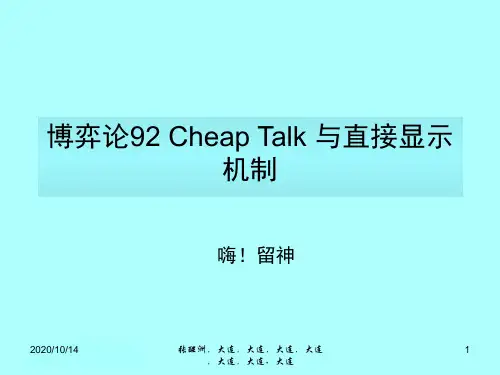
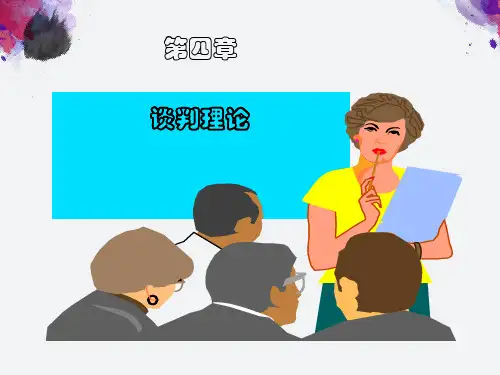

On cheap talk in gamesJia-wei LiRobotics Research Institute, Harbin Institute of TechnologyHarbin, PRC 150001lijiawei@AbstractIt has been proved in many studies that cheap talk has great influence on the players’choices of strategies in games. But the effect of cheap talk has still not been properlyevaluated in game theory. Based on a novel game model with parameters denotinghow one player cares for the other’s payoff, we can take the relations between playersinto account in games and extend the use of games theory. In this study the effect ofcheap talk was analyzed by using the new game model. Two examples – a modifiedprisoners’ dilemma and threatening letter – were studied to explain how cheap talkcould greatly influence the results of games.1 IntroductionTwo types of games have been examined in game theory: cooperative (1) and non-cooperative (2). Although some scholars regain interests for cooperative games somewhat recently for Nash equilibria have not proved satisfactory as a solution concept in some fields, the most important work come from non-cooperative analysis undoubtedly (3, 4). Many truths have shown that cheap talk has great influence on the strategies a player chooses even in a non-cooperative game. But the effect of cheap talk has still not been properly estimated in game theory. Stein (5) testified that Federal declarations have influence on the policy but couldn’t calculate it accurately. Matthew (6) studied how could President use veto to affect the vote of legislature. Crawford and Sobel (7)examined the implications of cheap talk in a game in which one player send information to another player who has to choose an action. Effect of cheap talk was denoted by cheap talk extension -set of outcomes- that can be implemented in equilibrium.In games with complete information the only issue is the possibility of correlating actions by cheap talk, while in games with incomplete information there is in addition an issue of coordination on the basis of private information (8). Aumann and Hart (9)use the notion of a bi-martingale to characterize the set of equilibrium payoffs in a cheap talk extension of a two-player game in which only one player has private information. E. Ben-Porath (10) studies conditions of Bayesian Nash equilibrium in games, which areextended by adding pre-play communication. In fact, it is the relations between players that determine whether a game is cooperative or non-cooperative. If we assume the relations between players are either cooperative or non-cooperative and don’t take account of the variety of the relations in the process of games, the function of cheap talk can’t be estimated properly.By using numerical values denoting how one player care for another’s payoff, a new game model taking relations between players into account was developed, which would extend the use of game theory to more general cases. Cooperative and non-cooperative games are both special cases in the frame of new game model. More complicated games such as combined games are possible to be analyzed with the new model. Then the effect of cheap talk on the players’ choices of strategies was investigated.2 A modified prisoners’ dilemmaThe well-known prisoners’ dilemma can be represented with the following matrix,(1) ⎥⎥⎥⎦⎤⎢⎢⎢⎣⎡−−−−−−)1,1()0,15()15,0()8,8(..),(Defect Coop Defect Coop II I where the numbers represent payoffs of the two prisoners. This game is non-cooperative because the two prisoners only care for their own profits, and the result of game is most likely to be Nash equilibrium (,). Now assume that there was a cheap talk between the two prisoners before the game. Prisoner II asked prisoner I to choose strategy, and claimed that he would choose at the same time, and threatened that he would disclose another crime committed by prisoner I to the police if he chose . That will cause payoff to prisoner I ..Coop .Coop Defect Defect .Coop 15−If prisoner I thinks this cheap talk is credible, the total payoffs turns to be⎥⎥⎥⎦⎤⎢⎢⎢⎣⎡−−−−−−−)1,1()0,15()15,15()8,23(..),(Defect Coop Defect Coop II I (2) Then prisoner I should choose .Defect If prisoner I doesn’t believe this cheap talk at all, the strategy he chose has no relation with whether or not prisoner II discloses him. If prisoner II destines to disclose him, the total payoffs will be⎥⎥⎥⎦⎤⎢⎢⎢⎣⎡−−−−−−−)1,16()0,30()15,15()8,23(..),(Defect Coop Defect Coop II I (3) Prisoner I ’s dominant strategy is by comparing (1) and (3)..Coop But, there is no reason for prisoner II to disclose prisoner I if he has chose , and there is no reason for prisoner II not to disclose prisoner I if he has chose .Defect .Coop How should prisoner I choose his strategy now?This is in fact a combination of two games. It is difficult to analyze this kind of problems using traditional game model because the relations between prisoners are not considered. Now we’ll introduce a new model for games.3 A new model for gamesDefinition 1: For players i and j in a game, relation is a numerical value denotes how player i care for player j ’s payoff. Specially, there is ij R 1=ii R .For example, shows player i don’t care for j ’s payoff at all, and i ’s attitude toward j is non-cooperative. means player i cares for j ’s income equal as that of his own. 0=ij R 1=ij R 10<<ij R indicates in what degree player i cares for j ’s income, and i ’s attitude toward j is cooperative. If 0<ij R player i would rather to have j suffered loss, this means i ’s attitude toward j is hostile.Definition 2: For players i , j and k in a game, inferred relation jk i R is a numerical value denotes playeri thinks how player j cares for player k ’s payoff. Specially, There is1=jj i R . Similarly, 0=jk i R means player i thinks player j don’t care for k ’s payoff at all. 0>jk i R meansplayer i thinks player j ’s attitude toward k is cooperative. And 0<jk i R meansplayer i thinks player j ’s attitude toward k is hostile.ij R and ji i R character the relations between player i and j from the viewpoint of player i , and thenumerical values of them are determined by foregone games.We call matrix (1) objective payoffs because it is the viewpoint of a third party and it has no relation to the players’ subjective thought. As opposed to objective payoffs, subjective payoffs of a player are his subjective consideration of objective payoffs.Definition 3: For a game , denotes how player i cares for player j ’s payoff, {n n u u S S G ,,;,,11L L =}ij R jk i R denotes player i thinks how player j cares for player k ’s payoff, we call objective payoffs and define subjective payoffs of player i , where),,(1n u u L ),,(1n i i u u L ⎪⎪⎩⎪⎪⎨⎧≠==∑∑==n k n k jk i nk n k ik n j i j i s s s u R j i s s s u R s s s u 12112121 if ),,,,( if ),,,,(),,,(L L L (4) For example, if objective payoffs are () for strategies (,) in a two players’ game, subjective payoffs of player 1 are (,21,u u 1s 2s 2121u R u +12112u R u +). Similarly, subjective payoffs of player 2 are (21221u R u +,).1212u R u +New Game Model : {}R R U S G ;;;= is a n-player game, where ),,(1n S S S L = are strategies of players, are objective payoffs, },,{1n u u U L =},,{1n R R R L = are relations between players, },,{1R R R n L = are inferred relations between players. Each player will choose strategy based on his subjective payoffs.Obviously, subjective payoffs of player i will be equal to the objective payoffs when there is 0==jk i ij R R (,), and it becomes a non-cooperative game if there is j i ≠k j ≠0==ik j ji R R (, ) at the same time. This shows that non-cooperative games are just special cases of the new game model.j i ≠k i ≠Now let’s analyze an example of prisoners’ dilemma with objective payoffs (1) by using this new game model. Suppose relations between prisoner 1 and 2 are , inferred relations are },{2112R R },{122211R R . The subjective payoffs matrix for prisoner 1 is⎥⎥⎥⎦⎤⎢⎢⎢⎣⎡−−−−−−−−−−−−)1,1()15,15()15,15()88,88(..),(211122*********R R R Defect R R R Coop Defect Coop II I (5) Prisoner 1 actually makes decision according to his subjective payoffs. When 14112≤R and 141211≤R , is prisoner 1’s dominant strategy. When .Coop 8712≥R and 7211≥R , becomes prisoner 1’s dominant strategy.Defect Obviously, cooperative games and non-cooperative games are all included in the new model. Specially, we say the relations between two players are hostile when there are 0<ij R and .0<ji R For a game with complete information there should be jk i R jk R = for any (,k j i ,,j i ≠k j ≠) before the game, which means that the relations between any two players is common knowledge. For a game with perfect information there should be jk i R jk R = after the game.Most of real-life games are games with imperfect and incomplete information because of the nature of and ij R jk i R . only can be known by player i exactly and other players have to estimate it. Even if player i declares its real value, other players have to judge whether it is credible. ij R jk i R can be verified by the results of games and information exchange, but player i can’t make sure jk i R always equal to . jk R 4 Cheap talk in gamesIt has been proved by many truths that cheap talk has great influence on players’ choice of strategies. How can cheap talk influence the results of games will be analyzed based on the new game model.Since it is according to subjective payoffs for a player in games to choose his strategies, relations between players have influence on every player’s decision-making as well as objective payoffs. For instance, the strategies of player i in a two-person game are determined by strategy set and relations and U ij R ji i R . When there is =ij R 0>ji i R , player i wants to cooperate with player j and knows that player j wants to cooperate with player i . Then a promise of cooperation proposed by player j is credible for player i here.When there is =ij R 0<ji i R , player i expects player j to suffer loss in the game and knows that player j expects player i to suffer loss in the game. Then a threat of defection proposed by player j is credible for player i in this instance.When there is and 0=ij R 0=ji i R , neither of promises of cooperation and threats of defection is credible for player i . If there is and 0=ji R 0=ij j R at the same time the game is non-cooperative, and cheap talk has little effect on it.When there is ≠ij R ji i R , the relations between players will be complicated and there will be deceiving, commiserating or dedicating behavior in the game. This type of problems will be discussed in[11].In conclusion, cheap talk of cooperation is credible in cooperative games, and cheap talk of threat is credible in hostile games.One player i with higher will receive higher long-term payoffs in repeated games. This is the motivity for player i to keep higher (positive at least). Hence, ji R ji R ji i R can also denote the degree of credit on how player i trust in player j . The larger ji i R is the higher degree player i trust in player j . Suppose that two players promise to each other that they will choose strategy , the possibility of coming forth of is mainly determined by*S *S ji i R and ij j R . In the event doesn’t come true, there must be at least one player whose payoff does not accord withhis anticipated value after the game. Assume that there is difference value *S i u ∆ between player i ’sintending payoff and his real one and i attribute ij u ∆ to playerj ’s not abidance of promise, there will be ji i R ∆)(ij u f ∆=, where ji i R ∆ is the change of ji i R . In general is in accordance with ij R ji i R , hence not coming forth of will change at least one player’s credit (*S ji i R ) and attitude () to others. ij R In the event of one player departures from his promised strategy , it usually causes other players’ j *Spayoffs decreased and consequently causes ji i R and decreased, so each player has positivity to keep his promise in general cases.ij R For example, a conceited man in a bar claimed that if anyone wins him in hand wrestling he would pay for everyone’s beverage, but he lost the game as a result. Of course the man is unwilling to pay, but that action will cause his credit (j ji i R ,L jk k R ) declined. If he cares for his credit more than that money, he would choose Pay. This example indicates that the change of ji i R can be looked as a kind of payoff for player . On condition that a player’s credit lowers, his long-term payoffs will decrease and the possibility of successful cheap talk will also decrease. Sometimes cheap talk is not cheap.j Now lets analyze the modified prisoners dilemma of Section 1. If prisoner II chooses strategy, objective payoffs will be (Disclose 0,15−), and subjective payoffs of prisoner II will be ().2115,15R −−Disclose is prisoner II ’s dominant strategy if there is 021<R . Because is unknown to prisoner 21R I , he can only use the evaluated value 211R . If there is 0211>R , prisoner II will not choose . Since must decline if prisoner Disclose 21R I chooses and the worst result for prisoner .Coop I is that prisoner II chooses , prisoner Disclose I should choose so far as there is Defect 0211≥R at the beginning. How about the case of 0211<R ? If prisoner I chooses , prisoner .Coop II destines to choose . If prisoner Disclose I chooses , whether or not prisoner Defect II disclose prisoner I relies on prisoner II ’s attitude to credit drop 211R ∆. Suppose prisoner II considers that 211R ∆ is equal to payoff (there must be ), prisoner '2u 0'2<u II will choose if , otherwise he will not choose . Hence prisoner 1 should choose if there is Disclose 01521'2>−R u Disclose .Coop 015211'21>−R u , where '21u is evaluated value of . Otherwise prisoner I should choose '2uDefect .5 Example of threatening letterSuppose that a famous singer A received a threatening letter while she was preparing to hold vocal concert at a city. The threatening letter says there would be a bomb attack if the vocal concert held. Now A is confronted with the choice of either or Cancel the concert. By assuming that there is a player B who has sent the threatening letter, the objective payoffs in this game are as following matrixContinue ⎥⎥⎥⎦⎤⎢⎢⎢⎣⎡−−−−)0,3()0,3()0,20()10,20( ),(Cancel Continue attack No Attack B A (6) Nash equilibrium is () in this case. Since bomb attack decreases both sides’ payoffs the players will choose Nash equilibrium as their strategies. Thus threatening letter has no use at all. But this is not always the fact.0,20Now that it is pay to get mental satisfaction even if it takes some money, for example paying for a concert, it is also not irrational to revenge enemy by paying out some cost. Accordingly A will suppose there exists B with enmity to her (0<BA A R ).For there is , A ’s subjective payoffs are0=AB R ⎥⎥⎥⎦⎤⎢⎢⎢⎣⎡−−−−−−−)3,3()3,3()20,20()2010,20( ),(BA A BA A BA A BA A R R Cancel R R Continue attack No Attack B A (7) If 41−<BA A R , is the dominant strategy of player B , and A should choose . Otherwise A should choose . In this way, the following questions are important to A : Is there somebody with enmity to A ? How degree the enmity is? If A believes that it is impossible to be any person with enmity to her, the threatening letter may be only a kidding. Otherwise A maybe chooses . Attack Cancel Continue Cancel Being a cheap talk in this example, the threatening letter implies information , and this will change the value of 0<BA R BA A R and influences A ’s choice of strategy.Cheap talk has a great influence on players’ decision-making because repeated games and combined games are prevalent in real-life world. Even if the relations between players are non-cooperative thefunction of cheap talk can’t be neglected because it can change the relations between players, which influence the players’ long-term payoffs to a large degree.6 ConclusionCheap talk has an influence on relations between players and consequently changes the results of games. On condition that relations between players were neglected the function of cheap talk should not be estimated properly. Based on a new game model with parameters denoting how one player care for other’s payoff, we could take the relations between players into account in games and extended the use of games theory to more general cases. Then the importance of cheap talk can be explained with the new game model. We believe that more and more economic and social phenomenon will be properly analyzed by using the new game model.References[1] V. Neumann, J.,Morgenstern (1953) Theory of Games and Economic Behavior, 3rd ed. Princeton UniversityPress, Princeton[2] J. Nash (1950) Equilibrium points in N-Person games. Proceedings of the National Academy of Sciences, 36,48–49[3] R. Selten (1965) Spieltheoretische Behandlung eines Oligopolmodells mit Nachfragetragheit. Zeitschrift furGesamte Staatswissenschaft, 121, 301-24[4] J. Harsanyi (1967) Games with incomplete information played by Bayesian players part I II and III. ManagementScience. 14, 159-82, 320-34, 486-502[5] J. Stein (1989) Cheap talk and the Fed: a theory of imprecise policy announcements. American Economic Review.79, 32-42[6] S. Matthews (1989) Veto threats: rhetoric in a bargaining game. Quarterly Journal of Economics. 104, 347-369[7] V. Crawford and J. Sobel (1982) Strategic information transmission, Econometrica. 50, 579–594[8] I. Barany (1992) Fair distribution protocols of how the players replace fortune, Math. Oper. Res. 17, 329–340[9] R. Aumann and S. Hart (1996) Longneg otiations, cheap talk, Mimeo, Center for Rationality, The HebrewUniversity of Jerusalem.[10] E. Ben-Porath (2003) Cheap talk in games with incomplete information. Journal of Economic Theory, 108,45–71[11] Jia-wei Li, On the relations between players in games. To be published in International Game Theory Review.。